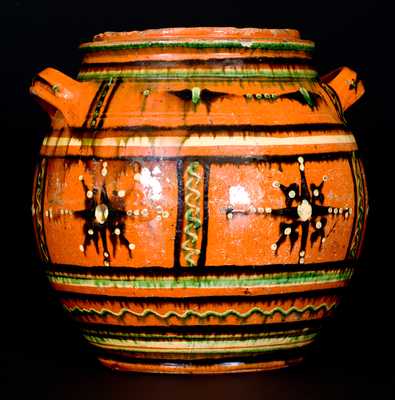Exceedingly Rare Smaller-Sized Moravian Redware Turtle Bottle with Copper Glaze, Salem, NC origin, circa 1800-1850, molded bottle in the form of a turtle with detailed shell, hand-incised toes, and raised head forming the vessel's spout, the surface covered in a green lead-and-copper glaze. Among the most prized animal forms produced in North Carolina's Moravian redware tradition, this turtle bottle is the only example of this specific size and style of which we are aware. Johanna Brown's Ceramics in America 2009 article, "Tradition and Adaptation in Moravian Press-Molded Earthenware," notes that two different types of turtle bottles, sometimes recorded in Salem pottery inventories as "terrapins," were produced (Brown, p. 115). As further stated by Brown in her Ceramics in America 2010 article, "A Recently Discovered Moravian Turtle Bottle," the mold for the type of bottle seen in this auction was made using an Eastern box turtle shell. Examples of the box-turtle-type bottles typically measure 7 1/4" long; however, the bottle in the auction measures to a smaller 6 1/2" size. It appears that this smaller size was previously only known from the mold that produced it, as we can find no documentation of intact examples. The mold from which this bottle was produced, owned by the Wachovia Historical Society, is illustrated in Brown's "Tradition and Adaptation in Moravian Press-Molded Earthenware," p. 114, fig. 14. Differences between the larger and smaller box-turtle-type bottles can be seen not just in the size, but also in the placement of the legs and tail, the 7 1/4" turtle depicted with the feet and tail on the underside of the shell and the 6 1/2" turtle featuring the legs and tail tucked at the animal's sides. Also of note is the shape of the eyes, with the larger size portraying the turtle with oval eyes and the smaller size having round eyes, as well as differences between the plates on the underside of the turtle's shell. Only a small group of Moravian turtle bottles produced from any mold have survived. The fragility of the form resulted in losses or significant damage to some, and the condition of this example is noteworthy for the retention of the spout and lustrous, well-conditioned glaze. This exciting recent discovery helps fill a void in the large body of extant Moravian molds from which no surviving works can be found. Literature: See Brown, "Moravian Press-Molded Earthenware", Ceramics in America 2009, pp. 114-115 for the mold used to produce this bottle displayed with a 7 1/4" turtle bottle; See also Bivens, The Moravian Potters of North Carolina, pp. 212-213, for photos of related bottles. Provenance: Recently surfaced in the Mid-Atlantic. A crack extending across turtle's back, continuing across much of underside. (This crack does not extend completely around the bottle.) A shallow chip to lower edge of spout and very minor chip to edge of spout. A 5/8" flake to underside of bottle near edge. In-the-firing tripod kiln furniture marks on underside. Wear to end of tail. Spots of additional minor glaze wear. L 6 1/2".

























